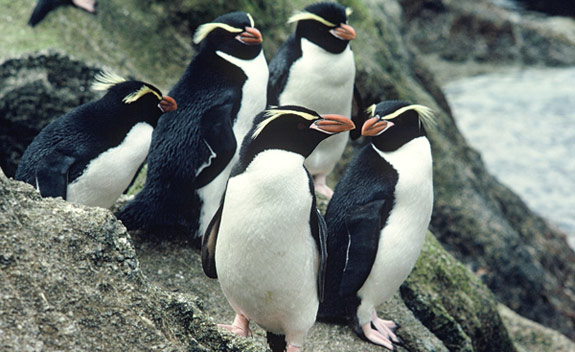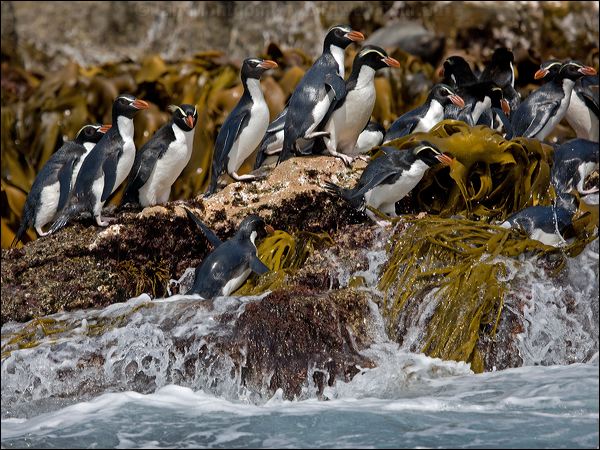 The Snares penguin (Eudyptes robustus), also known as the Snares crested penguin and the Snares Islands penguin, is a penguinfrom New Zealand. The species breeds on The Snares, a group of islands off the southern coast of the South Island. This is a medium-small, yellow-crested penguin, at a size of 50–70 cm (20–28 in) and a weight of 2.5–4 kg (5.5-8.8 lbs). It has dark blue-black upperparts and white underparts. It has a bright yellow eyebrow-stripe which extends over the eye to form a drooping, bushy crest. It has bare pink skin at the base of its large red-brown bill.This penguin nests in small (10 nests) to large (1200 nests) colonies under forest cover or the open. The main colonies are located onNorth East Island, other colonies are established on Broughton Island as well as the rocky Western Chain. The Snares penguin's main prey is krill, supplemented by squid and small fish. The species is currently rated as vulnerable by the IUCN as its breeding range is restricted to one small island group. The current population is estimated at around 25,000 breeding pairs.
The Snares penguin (Eudyptes robustus), also known as the Snares crested penguin and the Snares Islands penguin, is a penguinfrom New Zealand. The species breeds on The Snares, a group of islands off the southern coast of the South Island. This is a medium-small, yellow-crested penguin, at a size of 50–70 cm (20–28 in) and a weight of 2.5–4 kg (5.5-8.8 lbs). It has dark blue-black upperparts and white underparts. It has a bright yellow eyebrow-stripe which extends over the eye to form a drooping, bushy crest. It has bare pink skin at the base of its large red-brown bill.This penguin nests in small (10 nests) to large (1200 nests) colonies under forest cover or the open. The main colonies are located onNorth East Island, other colonies are established on Broughton Island as well as the rocky Western Chain. The Snares penguin's main prey is krill, supplemented by squid and small fish. The species is currently rated as vulnerable by the IUCN as its breeding range is restricted to one small island group. The current population is estimated at around 25,000 breeding pairs. |
| A GROUP OF SNARE PENGUINS |
 |
| A PIC OF SNARE PENGUINS GOING TO HAVE A GOOD SWIM |
Although Snares penguins are not currently threatened, they are considered a vulnerable species. If a threat arose, it could quickly wipe out their population because their breeding grounds are confined to a small island group.The diet of Snares penguins usually consists of krill of the species Nyctiphanes australis, small fish, and cephalopods. One study found that about 60 percent of the mass of stomach contents from Snares penguins consisted of krill, 30 percent was fish, and about 10 percent was cephalopods.Predators of adult Snares penguins are sea lions and leopard seals. Their eggs and chicks are hunted by skuas and petrels.